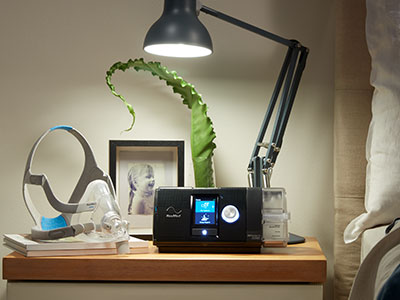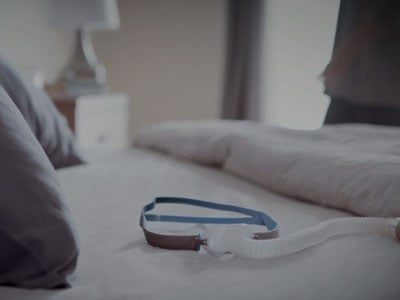Find answers to the questions that your patients frequently ask about device cleaning & maintenance, tips for using devices, and travel solutions.
There could be a number of reasons for this. The following suggestions should help you to identify and resolve the problem:
We suggest that you try the following solutions:
Some people experience bloating when using a PAP device, particularly when treatment first starts. If your patient is having trouble with bloating, we suggest trying the following solutions.
We recommend that you try the following solutions with your patient:
The Power Save mode is designed to reduce energy consumption. It is activated by pressing the Start/Stop button for 3 seconds. We advise at least a 2-minute wait after the end of therapy if your patient still wishes to unplug the device.
If you are using telemonitoring to track your patient’s data, the device needs to remain turned on so the data can be sent.
Regular maintenance and cleaning will keep a humidifier in good working order and help patients enjoy a fresher therapy experience.
Each humidifier user guide contains instructions on cleaning that specific type of device and its components. In general, the water tub should be washed every day in warm water with a mild detergent, then rinsed thoroughly with clean water and left to dry away from direct sunlight. Every month, the water tub should be inspected for wear and deterioration and replaced if any component is cracked, cloudy or pitted.
Patients should not use any of the following to clean their humidifiers as these solutions may cause damage and reduce the life of the product:
For your convenience, here are the cleaning instructions for ResMed’s heated humidifier:
Every day
Every month
Please note that the disassembled tub lid, plate and base may also be washed in a dishwasher on the delicate or glassware cycle (top shelf only). White powder deposits in the water tub can be removed using a solution of one part household vinegar to 10 parts water.
Please refer to the tubing user guide for detailed instructions on cleaning. In general, the air tubing should be removed every day by pulling on the finger grips on the cuff. Hang the tubing in a clean, dry place until its next use.
Please note: Air tubing should not be hung in direct sunlight as it may harden over time and eventually crack.
Air tubing should not be washed in a washing device or dishwasher.
Every week, patients should remove the air tubing from their therapy device and mask by pulling on the finger grips on the cuff, then wash the air tubing in warm water using mild detergent. They should rinse the tubing thoroughly, hang it up in a clean, dry place, and allow it to dry. They should reconnect the air tubing to the air outlet and mask next time they use the device.
ResMed has recommended and validated procedures for cleaning and disinfecting heated humidifiers for multipatient use in a sleep lab, clinic or hospital. Please refer to our ResMed humidifier disinfection guide for these instructions.
Please note that the steps for disinfection vary regionally. As such, each healthcare facility should consult its own procedures before carrying out those in this guide.
We recommend using the SD (Secure Digital) cards that were supplied by ResMed as these have been validated to conform to legal safety standards. ResMed has selected several SD cards that conform to legal safety requirements (e.g. IEC 60601-1) and supplies these with the therapy device or as accessories. Not all SD cards on the market conform to legal requirements or have been tested and validated to work with ResMed’s devices.
It varies depending on the sleep therapy device. For example, on an S9 therapy device a 1GB SD card easily stores 365 days of usage data, 30 days of detailed data, and seven days of high-resolution data. On all AirSense 10 or AirCurve 10 therapy devices, you can get up to 365 days of usage data, and 30 days of both detailed and high-resolution data.
No. These SD cards would work with their device if they were used with an adapter, but they have not been shown to meet the IEC 60601-1 medical electrical equipment safety requirements for this therapy device. As a result, ResMed recommends that they should not be used.
No. Secure Digital High Capacity (SDHC) cards, as well as mini and micro SDHC cards and SDXC cards, do not work with any ResMed sleep therapy devices.
On the AirSense 10 and AirCurve 10 therapy devices, you will need to open the SD card cover to access to the SD Card. To remove the SD card, you need to push the SD card in to release it, and then pull it out. To insert the SD Card, push the SD card into the device until it clicks. We recommend that you insert the SD card when the device is turned off. It is also possible to insert the SD card when the device is powered but not delivering therapy. If the card needs to be removed to check data, please wait at least two minutes after stopping therapy before removing the SD card from the device.
On all AirSense 10 and AirCurve 10 devices, there is a LED next to the SD card slot that indicates when it is safe to remove the SD card. When the LED is flashing, the device is using the SD card and the SD card should not be removed. You can safely remove the SD card when the LED turns off.
Yes. ResMed offers an 90W power supply that can be used to connect a ResMed sleep therapy device and its humidifier to the mains electricity supply. If your patient doesn’t need a humidifier, the smaller, lighter 30W Power Supply might be more convenient and is available for the S9 therapy devices only.
These power supplies can be plugged into wall sockets with an AC configuration and cannot be used with a DC configuration. Patients who need to power their sleep device from a car or boat battery or similar, will need the DC converter.
Yes. ResMed offers a DC converter that patients can use to power their ResMed sleep therapy devices from a car or boat battery or similar. Please note that DC converters are not to be used with ventilators.
Yes. Our SlimLine tubing is one of the slimmest, most flexible tubes on the market. It’s 40% lighter, 20% thinner and takes up 35% less space than traditional CPAP tubing, making it ideal for travelling. The streamlined design also makes it easier for patients to move around in bed without pulling on the mask, so their mask and seal stay stable.
ResMed’s AirMini, AirSense 10 and AirCurve 10 travel bags are the ideal travel companions for ResMed’s sleep therapy devices. These sturdy, convenient hold-alls protect the therapy device, the humidifier, tubing and mask when patients are travelling. They also have a storage compartment for extras, such as cleansing wipes or spare filters.
Our travel bags are well-padded, easy to pack and easy to carry by the handles or the convenient shoulder strap.
We offer sturdy, custom-designed travel bags for our Astral and Stellar ventilators and associated accessories. All of our bags can be attached to a bed or a wheelchair, and offer access to the user interface so patients and carers can view and access alarms and controls without removing the device.
The Astral mobility bag protects your patient’s Astral life support ventilator and accessories during travel. The Mobility Bag is easy to carry by hand or as a backpack thanks to its broad, comfortable shoulder straps. The user interface is fully accessible while the ventilator is inside the bag and the Astral’s alarm systems function inside the Mobility Bag at a volume range of 45–75 dBA (in five steps) for greater safety and peace of mind.
The Stellar mobility bag gives your patient the reassurance of sturdy, purpose-built protection against knocks, dust and water.

To maintain good quality therapy it’s important for your patients to regularly replace their devices and components.
